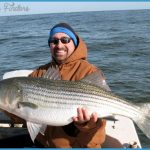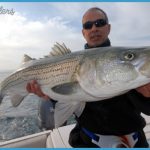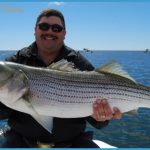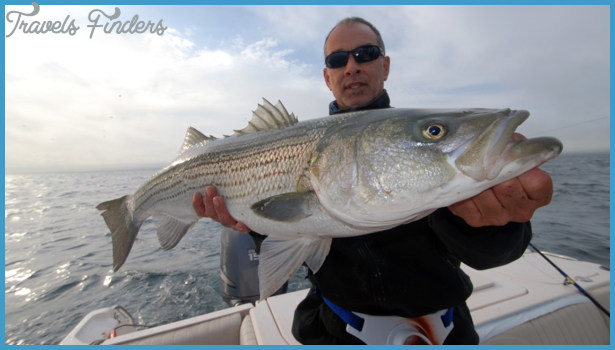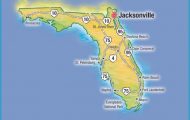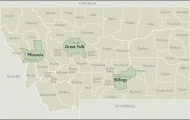Striped bass, Morone saxatilis, have made a dramatic comeback off Maine’s rugged, 3,500-mile-long coast. Special regulations, in the form of a 36-inch minimum length limit, a virtual catch-and-release, artificials-only law for certain areas during part of the year, and a ban on the use of gaffs, have combined to make Maine a premier striped bass location. For details on Maine’s striped bass regulations, write to the Maine Department of Marine Resources, Station 21, Augusta, ME 04333 or call 207-624-6550. Regulations are always subject to change, so it is best to keep up with the current laws.
School stripers, averaging from 2 to 15 pounds, make up the bulk of the catch, but fish weighing up to 50 pounds are taken each year, especially by anglers using bait.
Stripers move inshore with the coming and going tides. Dead high and low tides are not good times to fish unless you can locate a deep hole in a tidal river where bass are holding.
Striped bass are voracious feeders, gorging themselves as they slash into schools of bait fish. Herring, menhaden, silversides, sand lances, and eels are favorite forage species. Sand lances have the peculiar habit of burying themselves in the sand as the tide retreats, and emerging with the incoming tide. Striped bass, attracted by the emerging sand lances, will often be seen searching the bottom of tidal rivers on an incoming tide. Marine worms are yet another inducement for striped bass to enter shallow water. Clam diggers, while turning over the tidal flats, leave countless marine worms exposed. When the tide comes in, the bass have a feast on the helpless worms.
Stripers are nocturnal, providing action 24 hours a day, as long as the tide is moving.
Anglers searching for striped bass rely upon their eyes as much as anything else, since stripers are easily visible as they feed. Also, sea birds are attracted to striper activity. Swirling herring gulls often signal a striped bass feeding frenzy.
Regarding the striper’s future in Maine, Governor Angus King has promised that as long as he is in office, there will be no commercial fishing for striped bass in Maine. The immense economic value of Maine’s recreational striped bass fishery is certainly worth protecting, and it is hoped that future lawmakers will follow King’s lead.
Most of the Maine striped bass you will catch will be somewhat below the minimum length limit, but the potential is always there to take a legal fish, a trophy in anyone’s book. Perhaps that hope is part of the glamour of this new and popular fishery.
Techniques
Spin fishing – You don’t have to invest in specialized tackle to be successful at striped bass fishing. Standard spinning gear will suffice. You should always rinse your tackle off with fresh water after each use, to nullify the corrosive effects of salt water.
Spinning gear allows you to cast from shore or from a boat. Most Maine striped bass anglers use spinning tackle. Use at least a medium-weight rod and reel. Lines should test at least 12 pounds, with 15-pound test being more practical.
Stripers respond to a wide variety of artificial lures, both surface and subsurface. If you are geared up for freshwater bass fishing, any of your surface lures will work for stripers.
If you want to stock up on saltwater lures, get a few of the new cigar-shaped sinking poppers. These lures are made to sink slowly, so you need to constantly work them to keep them at the surface. Stripers love them.
Trolling with Rapalas and other sinking minnow imitations is an effective method. Tube-style lures, made of surgical tubing, can be trolled as well. These imitate eels and are quite effective.
Shore-based anglers can do well with metal jigs and spoons. These need to be retrieved quickly for the best results. Stripers can swim at speeds of up to 40 miles per hour and often hit that speed when pursuing baitfish.
The new breed of plastic lures are deadly on striped bass. These lures have the feel of natural bait and the fish do not reject them as quickly as harder imitations. Using a plastic eel or baitfish imitation, allow the lure to sink and then apply a forceful twitch. Allow the bait to sink again and then bring the rod back. Repeat this process until it is time to recast. This is a productive and enjoyable method. When you feel a hit, strike with as much force as your tackle will allow. You might even strike several times to ensure a positive hookup.
Surf casting – Most anglers use heavy-duty spinning outfits for surf casting for stripers, but fly rodders have learned that they can get in on the sport too. When the tide is moving, bait fish are found near the breakers, and stripers are often there after the bait fish.
Cast your lure or fly as far as you can and fish it all the way in, even through the curling waves. Given the extreme clarity of Maine’s salt water, you may even get to see the striper as it strikes your lure. This is one of the best methods for fly-fishers to take truly large striped bass.
Fly patterns designed for striped bass fishing are becoming common. Large wet flies, tied on hook sizes 1/0 to 3/0, represent a variety of sea creatures, including sand lances, herring, squid, and mackerel. Popular patterns include Catherwood’s eel, Catherwood’s herring, Catherwood’s pogy, Whitlock’s sheep streamer, McNally smelt, Lefty’s deceiver, and a wide range of popping bugs. In the days before established patterns, some hardcore fly anglers used simple streamers tied with a silver tinsel body and a long, white hairwing. These primitive flies worked then and will work today.
Surf casting with a fly rod requires that you use a commercial or homemade casting basket to hold your loose fly line. Without a basket, your line will become hopelessly tangled and may pick up sand, which could damage your reel.
Fly rods should be at least 8-weight, with 9- and 10-weight preferred. Heavy freshwater fly reels will suffice, but saltwater reels are better, since they have the most powerful drag systems and are resistant to corrosion. Fly reels should have at least 100 yards of 18-pound test backing.
Spinning tackle should be medium-heavy, with 15- to 20-pound test line preferred. Plastic and metal minnow imitations work well, as do a wide range of poppers.
Fishing from a boat – A boat allows you to go to the fish, rather than hoping they come to you. You can tell when a school of stripers is working the bait fish, because of whirling sea birds. Sometimes you can even see plumes of water, the result of a striper “blowing up” on a bunch of bait fish. When you see this, get within casting range as quickly as possible. Any tackle can be used when casting to a school of striped bass from a boat. Take advantage of these feeding binges while they last, because they can end as quickly as they began.
If you don’t see any overt signs of activity, try trolling around points and river mouths, using large streamer flies or diving bait fish imitations.
Bait fishing – The largest striped bass are usually taken on bait. The use of bait does have a drawback. Mortality rates are high on released fish, something that doesn’t hold true for artificial lures and flies. Live eels are the favorite bait for striped bass, followed by mackerel and sandworms. Eels are difficult to handle, so you should keep them on ice to keep them dormant. Once you pick them up to hook them through the snout, they come to life in a hurry, covering you with slime.
Eels, mackerel, and sandworms are fished on the bottom during a moving tide. A sliding sinker rig is favored by many, but if you can get by without a sinker, so much the better.
If a small striper is deeply hooked, take care to cut the line close to the hook. Stay away from non-corrosive hooks when fishing with bait.
Best bets for Maine striped bass: Popham Beach, Site 7; Kennebec River, from Bath to Popham Beach, Site 16; St George River, Site 18; the shoreline along Belfast, Site 27; and the Penobscot River near Verona Island, Site 34.

